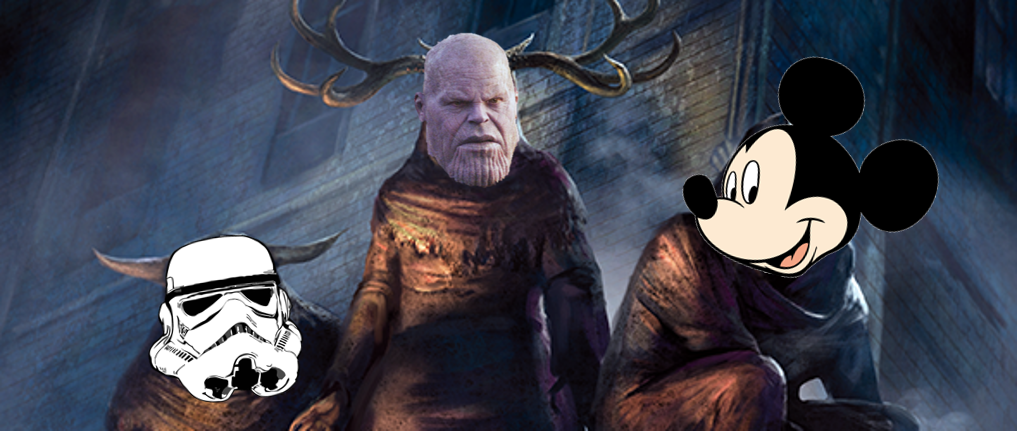
This is the second in a two-part exploration of the Disney-Fox deal. You can read part one here.
Though the Disney Company’s $71.3 billion bid to acquire 21st Century Fox has been met by pop-culture fans with rapturous glee, the threat of Disney establishing a modern monopoly on the entertainment industry may become a reality in this deal. There’s a logic to Disney purchasing the company that owns major stock in the streaming market plus intellectual properties closely tied to them, such as James Cameron’s Avatar (2009). The deal, however, will lead to Disney owning an estimated 30% of the film industry. Many may not mind a company like Disney owning so much stake in one industry, but there’s major concern when one considers the mediocre quality of the art Disney has produced in the last decade.
The Descent
In order to thoroughly critique the current state of Disney’s creative standard, we must once more delve into the company’s past. Previously, I’ve discussed the great success then-CEO Michael Eisner brought to the Disney Company in what would’ve been Disney’s downfall. Everything Eisner touched seemed to turn to gold, and for a while it looked like nothing could stop his revitalization of the Disney brand.
Unfortunately, the Euro Disney Resort happened. Now called Disneyland Paris, Eisner grossly overestimated how successful the park would be. The people of France protested en masse, calling the park a “Cultural Chernobyl” on announcement. Obscene costs, unrealistic expectations, and a poor reception on the resort’s 1992 opening left the $5 billion dollar resort with over $3 billion in debt by 1994, and for the first time, the shut-down of an entire Disney resort was growing more likely.
Suddenly, Eisner’s so-called “Disney Decade” became a spiral of hastily made financial decisions to prevent his failure. When businesses like Chuck E. Cheese’s, the Hard Rock Café, and Dave & Busters boomed in the 90s, Disney slapped together Club Disney, the ESPN Zone, and DisneyQuest, which like the Euro Disney Resort, all had ambitious plans that collapsed. Dozens of publicly announced theme park expansions and film projects were suddenly cancelled, while billions were spent trying to fix numerous disasters springing up across each theme park resort. They even tried buying out Universal Pictures, ultimately losing to Comcast, and Eisner’s reputation quickly shifted from Disney’s savior to a hack desperate to leech off the success of others.
Meanwhile, Disney Animation got experimental with films, ranging from successes like Lilo and Stitch (2002) to box office bombs like Atlantis: The Lost Empire (2001). They produced dozens of direct-to-video sequels, flooding the market with disappointing follow-ups to Disney classics. Even stranger, Disney produced live-action remakes of classic films like 101 Dalmations (1996), and started a line of films based on theme park attractions, resulting in the oft-forgotten failures of Tower of Terror (1997), Mission to Mars (2000), The Country Bears (2002), The Haunted Mansion (2003), alongside the disgustingly successful Pirates of the Caribbean: Curse of the Black Pearl (2003). It didn’t help that former Disney Studio chairman Jeffrey Katzenburg started directly competing with Disney through the creation of Dreamworks Pictures, garnering critical and financial acclaim.
Remembering the Past
Despite his best efforts, by 2004 the board of executives voted not to extend Eisner’s tenure as CEO. This latter half of Eisner’s tenure is what made him hated among the Disney fan community, as he stopped being fueled by creative risks, and only sought after bigger market sales. In the wake of Eisner’s departure, executives sought out his successor, the current spearhead of the Disney Company.
The irony is that Eisner’s spiral into dull corporatism was fueled by the same thing that caused the Disney Renaissance: competition and the risk of financial failure. As Iger’s Disney continues to both amass more capital and swallow up competition, there’s a logical assumption that the Disney Company now has more than enough assets to put towards innovating the industry, as founder Walt Disney often tried.
Walt Disney was told that both producing Snow White and the Seven Dwarves (1937) and opening Disneyland would be disasters that’d leave him broke. His own brother Roy told colleagues that Disneyland would make Walt “lose his shirt”! Yet these great risks born from a passionate, creative vision had massive payoffs which changed entertainment industries forever. Unfortunately, Iger’s vision of what the Walt Disney Company should be today doesn’t appear to be one of innovation or risk-taking, but of a company still tip-toeing around Eisner’s mistakes, trying to recharge from financial losses which have long been replenished.
As Watered Down as a Castle’s Moat
Even now, the decisions made by Bob Iger reek of Eisner’s desperation. In the last decade, Disney films have relied heavily on safe and formulaic stories about family, occasionally poking fun at genre conventions established by Disney to satisfy those that call their nit-picking “criticism”. Meanwhile, Pixar films has relied heavily on sequels, with films like Toy Story 3 (2010) and Finding Dory (2016) acting as beat-for-beat retellings of the previous film.
Furthermore, nearly every animated Disney film with a physical, conventional antagonist has followed the same “surprise reveal” twist used in Toy Story 2 (1999) and Monsters Inc. (2001). However, rather than leaving behind hints foreshadowing the reveal like in Toy Story 2, these films grab an innocuously inconspicuous character in the plot and throw away all characterization to have a super bad guy that’s evil because the plot says so. Films like WALL-E (2008), Up (2009), Toy Story 3, Wreck-It Ralph (2012), Frozen (2013), Big Hero 6 (2014), Zootopia (2016), Coco (2017), and Incredibles 2 (2018) are all guilty of this mistake. For those of you keeping track, that’s nearly 43% of all Disney animated films produced in the last decade that use the same “twist”. At this point, it’s no longer a twist, but a staple of Disney’s formula, and it’s resulted in watered down art in an industry that thrives on creativity.
As far as live action movies, Disney keeps producing inferior live action remakes of successful Disney movies through productions like Cinderella (2015) and Beauty and the Beast (2017), while also kick starting more films based on theme park attractions like the utter failure called Tomorrowland (2015) and the upcoming Jungle Cruise (2019). If Disney wants to take another swing at telling previous stories, that’s perfectly fine, but rather than water down already great stories, why wouldn’t Disney try and improve films like The Black Cauldron (1985) if they still cared about being innovative storytellers?
Like many other companies in the entertainment industry, Disney has announced their attempt to copy the success Netflix, Hulu, and HBO Go, by entering the streaming market through the birth of Disney+, the future home of all things Disney, Marvel, and Lucasfilm. With these subsidiaries alone, consumers will require a subscription to Disney+ to access nearly every major animated motion picture ever made, the increasing body of Star Wars content, plus nearly all film and television content based on one of the two major names in comics. Add into that mix the same company which owns The Simpsons, Family Guy, the Planet of the Apes franchise, animated films like the Ice Age series, the Alien and Predator series, plus the aforementioned Avatar, and the amount of content withheld behind yet another subscription paywall may be a little too much to justify for consumers who likely already shell out monthly subscriptions to other service providers.
What boggles my mind the most is how the same decisions made by Eisner that left him a despised stain on the Disney legacy have made Iger hailed as a visionary leader for the Disney company. As unfortunate as it is to say, it’s a fact: Disney doesn’t care about how their products make you feel, Disney is a company, and companies only care about your money. As long as their dull and formulaic films continue to make money, they won’t even consider shaking up their agenda, and as they continue the accumulation of more intellectual properties they can swell with safe formulas, they’ll only clog the entertainment industry in greater numbers until all that’s left is a wasteland bereft of imagination.
 George Ibarra is a Senior at Florida International University, pursuing a Bachelor’s Degree in English with a minor in Sociology, along with Certificates in Exile Studies and Film Studies.
George Ibarra is a Senior at Florida International University, pursuing a Bachelor’s Degree in English with a minor in Sociology, along with Certificates in Exile Studies and Film Studies.
